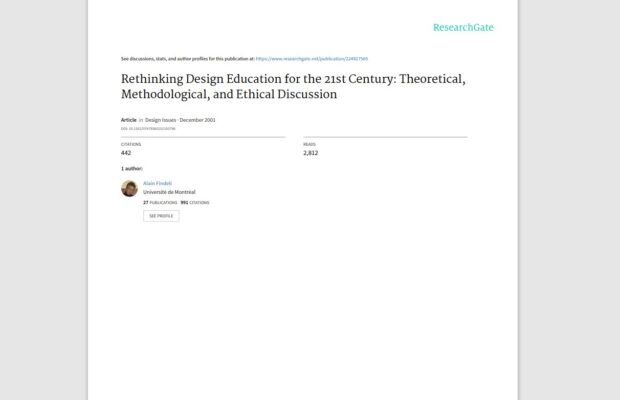
The core of ‘design thinking’ and its application by Kees Dorst
In the last few years, “Design Thinking” has gained popularity – it is now seen as an exciting new paradigm for dealing with problems in sectors as far a field as IT, Business, Education and Medicine. This potential success challenges the design research community to provide unambiguous answers to two key questions: “What is the core of Design Thinking?” and “What could it bring to practitioners and organisations in other fields?”. We sketch a partial answer by considering the fundamental reasoning pattern behind design, and then looking at the core design practices of framing and frame creation.

Design Thinking Comes of Age by Jon Kolko
In large organizations, design is moving closer to the center of the enterprise. This shift isn’t about aesthetics and product development, however. It’s about imparting the principles of design—collectively known as design thinking—throughout the organization. The approach is in large part a response to the complexity of many products, services, and processes. People need help—they need their interactions with technologies and other complicated systems to be intuitive and pleasurable. Design thinking is an essential tool for simplifying and humanizing.

5 examples of Design Thinking in business by Esther Han
Design thinking has become a business buzzword that’s changed how companies approach problem-solving. Countless brands, including GE Healthcare, Netflix, and UberEats, have utilized design thinking to develop effective solutions to challenges.
What is Design Thinking?
Design thinking is a user-centric, solutions-based approach to problem-solving that can be described in four stages.

The Designer’s Philosopher by Dr. Abhishek Kumar
Contemporary designers and architects would do well to revisit Gaston Bachelard’s work to imbue the spaces they create with meaning. As designers succeed, the temptation to follow and replicate tested methods grows stronger. The creative imagination, in its truest sense, also needs a break from the sterile templates of historical knowledge and stale world views

Rethinking Design Education for the 21st Century: Theoretical, Methodological, and Ethical Discussion by Alain Findeli
Design History and Design Studies : Methodological, Epistemological and Pedagogical Enquiry

Liquid Objects, Solid Meanings by Dr. Abhishek Kumar
With designers and manufacturers focusing more on creating aspirational value rather than enhancing the utility of a product, what does it mean for us as consumers? The values that have higher social and cultural approval like style, luxury, prestige and power have therefore become more profitable than investing in improving the product’s utility.

